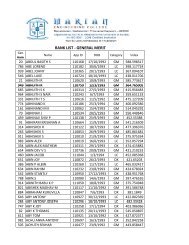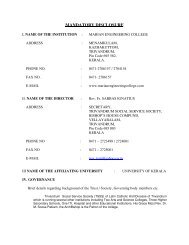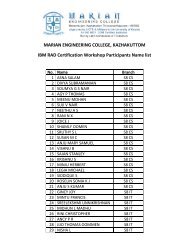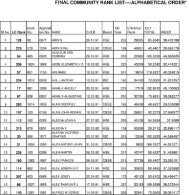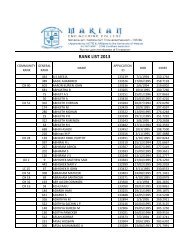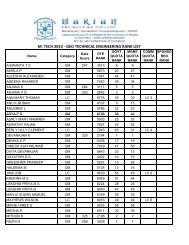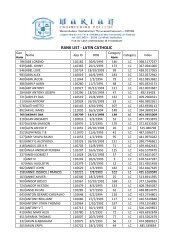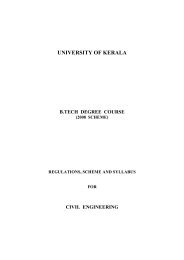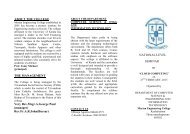UNIVERSITY OF KERALA - Marian Engineering College
UNIVERSITY OF KERALA - Marian Engineering College
UNIVERSITY OF KERALA - Marian Engineering College
You also want an ePaper? Increase the reach of your titles
YUMPU automatically turns print PDFs into web optimized ePapers that Google loves.
B.Tech Comp. Sc. & Engg., University of Kerala 65<br />
08.704 (4) PATTERN RECOGNITION AND SCENE ANALYSIS (ELECTIVE I) 3 – 1 – 0<br />
Module I (16 hours)<br />
Introduction. Probability – Probabilities of events, Random Variables, Joint Distributions and Densities,<br />
Moments of Random Variables, Estimation of Parameters from Samples, Minimum Risk Estimators.<br />
Statistical Decision Making – Bayes' Theorem, Multiple Features, Conditionally Independent Features,<br />
Decision Boundaries, Unequal Costs of Error, Estimation of Error Rates, The Leaving-One-Out Technique,<br />
Characteristic Curves, Estimating the Composition of Populations.<br />
Module II ( 18 hours)<br />
Nonparametric Decision Making – Histograms, Kernel and Window Estimators, Nearest Neighbor<br />
Classification Techniques, Adaptive Decision Boundaries, Adaptive Discriminant Functions, Minimum<br />
Squared Error Discriminant Functions, Choosing a Decision Making Technique. Clustering – Hierarchical<br />
clustering, Partitional Clustering. Artificial Neural Networks – Nets without Hidden Layers, Nets with Hidden<br />
Layers, Back-Propagation Algorithm, Hopfield Nets.<br />
Module III (18 hours)<br />
Processing of Waveforms and Images – Gray Level Scaling Transformations, Histogram Equalization,<br />
Geometric Image Scaling and Interpolation, Smoothing Transformations, Edge Detection, Laplacian and<br />
Sharpening Operators, Line Detection and Template Matching, Logarithmic Gray Level Scaling. Image<br />
Analysis – Scene Segmentation and Labelling, Counting Objects, Perimeter Measurement, Following and<br />
Representing Boundaries, Least Squares and Eigenvector Line Fitting, Shapes of Regions, Morphological<br />
Operations, Texture.<br />
Text Books:<br />
1. Pattern Recognition and Image analysis – E. Gose, R. Johnsonbaugh, S. Jost, , PHI<br />
Reference Books:<br />
1. Pattern Classification – R. O. Duda, P.E. Hart, D.G. Stork, , Wiley India Edition<br />
2. Pattern Classification and Scene Analysis – R.O. Duda and P. E. Hart, John Wiley & Sons, New York, 1973.<br />
3. Syntactic Pattern Recognition and Applications – K.S. Fu, , Prentice Hall, Eaglewood cliffs, N.J.,1982<br />
4. Pattern Recognition, 3 rd Edn – S. Theodoridis, K. Koutroumbas, Elsevier<br />
5. Neural Network for Pattern Recognition – C. M. Bishop, Oxford University Press, New York, 1998<br />
Internal Continuous Assessment (Maximum Marks-50)<br />
25 Marks - Tests (minimum 2)<br />
15 Marks - Assignments (minimum 3) such as home work, problem solving, literature survey, seminar,<br />
term-project, software exercises, etc.<br />
10 Marks - Regularity in the class<br />
University Examination Pattern<br />
PART A: Short answer questions 10 x 4 marks=40 marks<br />
All questions are compulsory. There should be at least three questions<br />
from each module and not more than four questions from any module.<br />
PART B: Descriptive/Analytical/Problem solving questions 3 x 20 marks=60 marks<br />
Candidates have to answer one question out of two or two questions<br />
out of four from each module.<br />
Maximum Total Marks: 100



